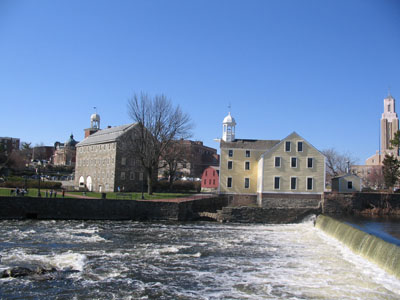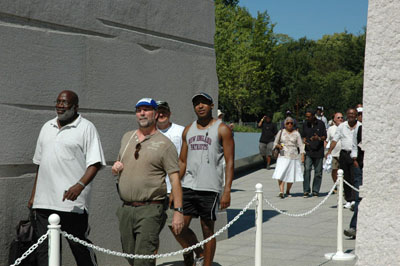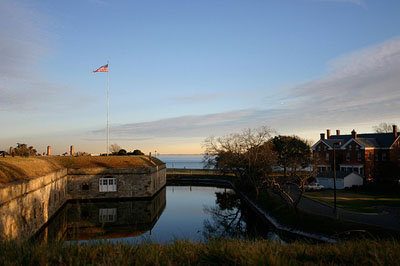
Creating new parks takes time for approval
The arrowhead of the National Park Service (NPS) is a well-known symbol in the United States, enough so that attaining the designation of being a national park is a goal for many parks, monuments, and historic sites.
National parks can only be created by an act of Congress and must be approved by the president.
Currently awaiting approval is legislation to turn the John H. Chafee Blackstone River Valley National Heritage Corridor into a national park. The valley encompasses land in both Rhode Island and Massachusetts and is chiefly known as the site where the first textile mill in the U.S. was built.
| Click on the video at the right to see an audio slideshow about creating new national parks prepared by writer Alysha Khan. Images are courtesy of the National Park Service. |
As a heritage corridor, the land is supervised by a federally appointed commission and receives some help from the NPS in terms of the administration of the park.
The corridor also receives some federal funding, but this is limited by legislation to the few years following the initial approval of the park. The corridor has received several extensions on this time limit, the most recent in 2011, but hopes to permanently solve this problem by becoming a national park.
“We got one last extension for another year until things get sorted in terms of becoming a national park,” said Joanna M. Doherty, community planner at Blackstone River Valley.
Before park advocates and sponsoring legislators can submit a bill to Congress, it must first undergo a special resource study by the NPS to determine if there is a legitimate reason for this area to be designated a national park. The study looks at the national significance of the land, the natural resources contained within, the overall need to protect the area, and the feasibility of maintaining the park.
Once the study is completed, NPS submits its recommendations to Congress. Completing this study can take several years, from getting funding to completing the survey to analyzing the findings.
The study can propose several alternatives to becoming a national park, such as financial assistance from charitable programs; a designation as a national landmark or wilderness; or simply continued management by the current owners.
At Blackstone River Valley, several of its 24 sites have been deemed significant enough to become a national park.
“That study is being completed,” Doherty said, “and the recommendation is that there is a potential for a national park within the region and it would focus on a few different sites that were found to be nationally significant.”
| The John H. Chafee Blackstone River Valley National Heritage Corridor is the home of the first textile mill ever built in the US. The park is currently trying to become a national park in order to retain its federal funding (Photos courtesy of the National Park Service). |  |
Even after a park receives a recommendation from the NPS, it can take several years before it’s approved by Congress and the president.
“Maybe one or two new ones are created a year, so it’s not super common,” Doherty said. “There is so much else going on in Congress. We just don’t know if or when it will pass.”
In November 2011, two new national parks came into existence — the Paterson Great Falls National Historical Park in New Jersey and the Fort Monroe National Monument in Virginia.
Legislation for Paterson was submitted in early 2009 even after the NPS recommended that the falls not become a national park.
“The main reason was that it was already designated a state park,” said Phil Sheridan, the assistant regional director of Communications in the northeast region of the NPS.
Congress, however, ignored the NPS recommendation and named Paterson Great Falls a national park. One stipulation was that the park has to acquire the land from the city of Paterson, N.J., a process that was complicated when the mayor was voted out of office.
Once a park is created, it must still meet certain criteria set forth by the park service. Paterson Great Falls must now, among other things, build a new visitor’s center and develop new programs for visitors.
“If you go to national parks, there is a commonality of things, from the way we do our maps to the way we do our signs,” Sheridan said. “It’s a consistency that people come to expect.”
Parks also have to go through a public planning process to determine how the park will be run and what services it will provide.
“Are we going to be having kayaks or are we going to be having bikes?” said Kirtsen Talken-Spaulding, superintendent for Fort Monroe. “Are we going to have a campground or are we going to have cave tours? Those are the sorts of things we look at. That then determines what kind of staff we need.”
At Fort Monroe, Talken-Spaulding is currently the only person on staff. Having a staff is important because, aside from supervising the park, they are responsible for bringing in additional grant money to the park.
 |
Visitors stroll around the Martin Luther King, Jr., Memorial, which is located in the National Mall at Washington, D.C. The monument took more than two decades to build because of the extensive approval process for new memorials. |
“We have probably 80 percent of our budget geared toward staffing,” Talken-Spaulding said. “Not like your usual federal government budget.”
At historic sites, like Fort Monroe, an additional main challenge is the restoration process. This involves returning the buildings in question to way they looked during the time period when they were most historically significant. In order to make this determination, a park needs funding to study the building, generate reports, and implement the restoration.
At Fort Monroe, one building was erected in 1819, but was historically important in 1860s.
“What did the building look like then?” Talken-Spaulding said. “Did it have a front porch back then? Since the 1860s, they have walled in what was the back porch of the building. Do we then take out that walling in and restore it back to the way it was in the 1860s?”
However, the fort currently has no money to fund the renovation of the fort or to hire staff because it did not exist when the federal budget for the 2011-12 fiscal year was created.
“The fiscal year began Oct. 1 and we didn’t exist on Oct. 1,” Talken-Spaulding said. “We can’t request funding for something that’s not on the books yet. We have no budget.”
According to Talken-Spaulding, the NPS is currently siphoning funds from other parks to support Fort Monroe.
Some new parks are not affected by this problem because ownership of the park is shared with other organizations. The Martin Luther King, Jr., Memorial in Washington, D.C., was created in August 2011 and is located within the National Mall and Memorial Parks.
It is managed by NPS personnel, but belongs to the National Mall. NPS money is also used to create educational programs for visitors.
“They care for them and takes care of things like trash and bathrooms and so forth,” said Carol Johnson, a public affairs officer for NPS. “Federal funds maintain the memorial.”
Though the process of becoming a national park is difficult, there are some distinct advantages to being a part of the NPS.
“When you put that national park service arrowhead out, it’s like the Good Housekeeping seal of approval,” Sheridan said. “This is an important place to go visit. It also conveys a good visitor experience.”
Funding is also a key incentive, even as federal budgets are being slashed.
“The park service tends to have funding to spend on things,” Sheridan said. “Do we have enough? Probably not. We have a $10 billion backlog in maintenance across the country, but we are still able to get lots of projects done. We find that we are better funded than a state park and definitely better than a municipal park.”
National parks are also economic engines that can bring additional revenue to an area.
“Nationally, it’s between $4 and $5 into the economy for every dollar invested in the park service,” Sheridan said.
At Blackstone Valley, however, Doherty is concerned that some of the sites that are not slated to become a national park may be upset.
“Some of the communities might feel a loss when we pull back in terms of our activities,” she said.
 |
The Fort Monroe National Monument in Virginia was known as a refuge for slaves during the Civil War and played an integral role during the war. The monument currently does not have the fund to restore its buildings. |
National Park Service Unit Designations
The designation of national park is just one of the many titles the National Park Service can give upon an area. Below is a list of the most common designations used, courtesy of the NPS.
National Park: generally large natural places that have a wide variety of attributes, and may be significant historic assets. Hunting, mining and consumptive activities are not allowed.
National Monument: The Antiquities Act of 1906 authorized the President to name any landmarks, structures, and other objects of historic or scientific interest situated on lands owned or controlled by the government as national monuments through a public proclamation.
National Preserve: National preserves are areas having characteristics associated with national parks, but in which Congress has permitted continued public hunting, trapping, oil/gas exploration and extraction. Many existing national preserves, without sport hunting, would qualify for national park designation.
National Historic Site: Contains a single historical feature that was directly associated with its subject.
National Historical Park: Generally applies to historic parks that extend beyond single properties or buildings.
National Memorial: A national memorial that commemorates a historic person or episode; it does not have to be located a site historically connected with its subject.
National Battlefield: This includes national battlefield, national battlefield park, national battlefield site, and national military park.
National Cemetery: There are presently 14 national cemeteries in the National Park System, all of which are administered in conjunction with an associated unit and are not accounted for separately.
National Recreation Area: Twelve NRAs are large reservoirs and emphasize water-based recreation. Five other NRAs are located near major population centers. Such urban parks combine scarce open spaces with the preservation of significant historic resources and important natural areas in location that can provide outdoor recreation for large numbers of people.
National Seashore: Ten national seashores have been established on the Atlantic, Gulf and Pacific coasts; some are developed and some relatively primitive. Hunting is allowed at many of these sites.
National Lakeshore: National lakeshores, all on the Great Lakes, closely parallel the seashores in character and use.
National River: There are several variations to this category: national river and recreation area, national scenic river, wild river, etc.
National Parkway: Refers to a roadway and the parkland paralleling the roadway. All were intended for scenic motoring along a protected corridor and often connect cultural sites.
National Trail: Linear parklands (more than 3,600 miles) authorized under the National Trails System Act of 1968.
Affliated Areas: Comprises a variety of locations in the United States and Canada that preserve significant properties outside the national parks system. Some of these have been recognized by Acts of Congress, others have been designated national historic sites by the Secretary of the Interior under authority of the Historic Sites Act of 1935. All draw on technical or financial aid from the National Park Service.
Other Designations: Some units of the National Park Service system bear unique titles or combinations of titles, like the White House and Prince William Forest Park.

Comments are Closed